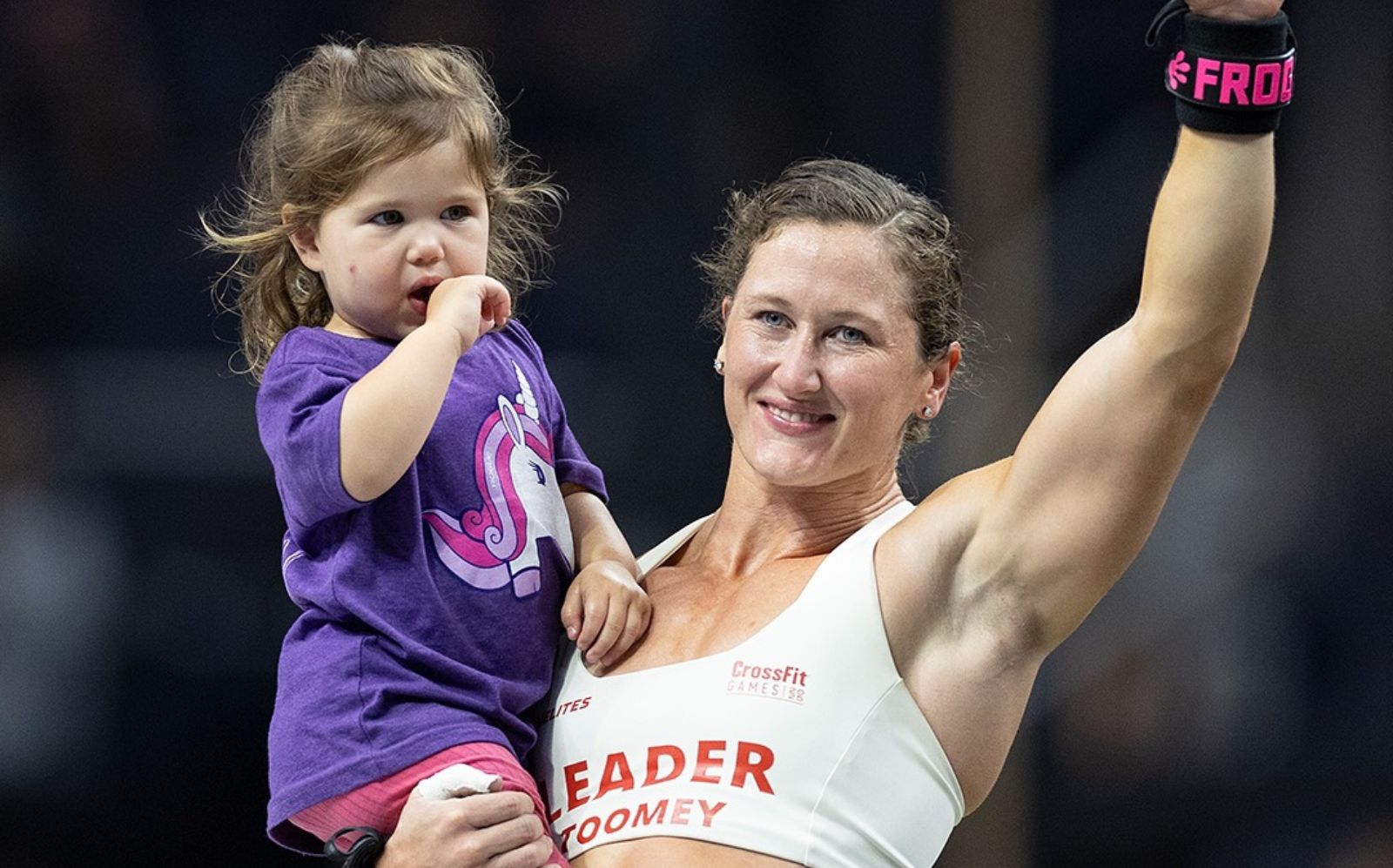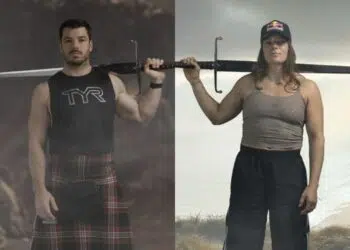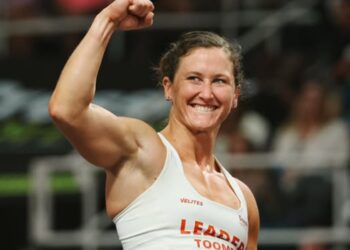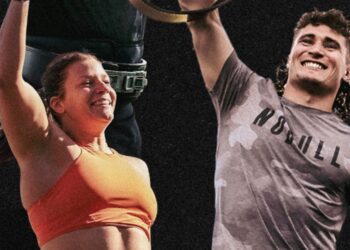It’s hard to believe that CrossFit has been around for over 20 years. What was initially considered a fitness fad quickly became one of the most popular workouts on the planet. There are now CrossFit gyms, called boxes, in most major cities.
CrossFit workouts, called WODs, are very diverse and involve many different exercises and training methods. For example, today you might be doing power cleans, box jumps, and rope climbing, while tomorrow could be running or rowing.
This constant rotation of training methods is designed to develop all of the fitness components equally so CrossFit athletes are fit, strong, powerful, and enduring. Most are lean and muscular, too.
The one thing that CrossFit WODs tend not to include is stretching. While CrossFitters are encouraged to stretch, many do not do enough flexibility work. Poor flexibility can make some CrossFit exercises even more challenging and could even lead to injury.
All CrossFitters need to stretch!
In this article, we reveal some of the best stretches for CrossFit athletes.
Level Up Your Fitness: Join our 💪 strong community in Fitness Volt Newsletter. Get daily inspiration, expert-backed workouts, nutrition tips, the latest in strength sports, and the support you need to reach your goals. Subscribe for free!
The Benefits of Stretching for CrossFit Athletes
Stretching doesn’t provide instant gratification, nor is it exhilarating, and won’t make you hot, sweaty, or tired. It won’t give you a pump, and you may even feel that it offers very few benefits.
As such, it’s all too easy to neglect stretching or only stretch occasionally.
However, regular stretching offers several benefits for CrossFit athletes and deserves a place in your workouts. These benefits include:
Increased range of motion
Whether you want to squat deeper, jump higher, or run faster, your range of motion matters. If you cannot move your limbs through their optimal range of motion, your movements will always be restricted and less efficient.
Fewer injuries
Flexible muscles are less prone to injury than tight muscles, especially during the dynamic, broad movements that often feature in CrossFit WODs. If you want to avoid pulled hamstrings and overstretched pecs, you need to include flexibility training in your workouts.
Better posture
Posture is the alignment of your joints, and it can be good or bad. Tight, inflexible muscles can pull your joints out of optimal alignment, affecting how that joint functions. Stretching hypertonic (over-tight) muscles can help correct these imbalances, so your joints can align and move correctly.
Relaxation and recovery
Stretching can be relaxing and enhance recovery. It eases aches and pains and also engages the parasympathetic nervous system, which has a calming effect on your nervous system. A few minutes of gentle stretching is good for your body AND mind.
Best Stretches for CrossFit Athletes
Every CrossFit athlete needs to work on their flexibility, but what stretches should you do? Here are a dozen to get you started!
- Runner’s lunge with rotation
- Seated hamstring stretch
- Cat-cow
- Downward and upward facing dog
- Squat with rotation
- Frog stretch
- 90/90 hip stretch
- Bootstrapper squats
- Kneeling forearm flexor stretch
- Kneeling chest opener
- Brettzel stretch
- Dead hang
1. Runner’s lunge with rotation
Stretching can be time-consuming, especially when you hold each stretch for a prolonged time. The runner’s lunge with rotation saves your valuable time by stretching multiple muscle groups simultaneously. Maybe that’s why this exercise is often known by another name – the world’s greatest stretch!
Steps:
- Take a large step forward with your right leg and get into a deep lunge. Your back leg should be straight.
- Lean forward and place both hands on the floor on either side of your feet.
- Keeping your left hand on the floor, rotate your shoulders toward your supporting leg and raise your right arm up toward the ceiling.
- Return your hand to the floor and repeat 4-6 times.
- Ease out of the stretch, switch leading legs, and repeat on the opposite side.
Muscles Targeted:
- Primary: Quadriceps, hamstrings, gluteus maximus, hip flexors, abductors, adductors.
- Secondary: Deltoids, obliques, pectoralis major.
Benefits:
- An excellent pre-workout mobilizer or after-training relaxer.
- One of the best full-body stretches you can do.
- Stretches your muscles in multiple planes (sagittal and transverse).
Tips:
- The longer your stance, the deeper your stretch will be.
- Lower your rear knee to the floor to make this exercise less intense.
- You can also do the runner’s lunge without rotation so you can focus on your lower body:
2. Seated hamstring stretch
While this stretch might not be exotic or exciting, it targets the muscles that are most commonly tight in CrossFit athletes – the hamstrings. Prolonged sitting and too little stretching mean that many CrossFitters have tight hammies. Tight hamstrings can affect everything from squat depth to lower back rounding during deadlifts.
Steps:
- Sit on the floor with your legs extended in front of you. Point your toes up toward the ceiling.
- Hinging from the hips, lower your chest down toward your thighs while reaching out to your toes.
- Go as far as you can without excessive rounding of the lower back.
- Hold for the prescribed time, and then relax and release.
Muscles Targeted:
- Primary: Hamstrings.
- Secondary: Gastrocnemius, gluteus maximus.
Benefits:
- A very straightforward stretch.
- An excellent way to improve your hamstring flexibility.
- Good for easing lower back tightness.
Tips:
- Loop a towel over your feet and gently pull with your arms if you cannot reach your toes with your hands.
- Focus more on lowering your chest to your leg than reaching for your toes to minimize lower back stress.
- Bend one leg and place the sole of your foot against the side of your knee to focus on one side at a time:
3. Cat-cow
Cat-cow is a yoga pose that stretches and mobilizes your spine and the muscles that control it. Many CrossFit exercises compress your spine, and it can be a relief to decompress and mobilize this hard-working region of your body. Do cat-cow before your CrossFit workouts or any time you want to ease the tension in your back.
Steps:
- Kneel on all fours with your spine and neck in a neutral position. Your hands should be shoulder-width apart, fingers pointing forward.
- Exhale and lift the center of your spine up toward the ceiling, creating a large rounded arch.
- Inhale and lower your abdomen toward the floor, lifting your head and butt as you do so.
- Smoothly alternate between these two positions for 5-10 reps.
Muscles Targeted:
- Primary: Erector spinae, rectus abdominis.
- Secondary: N/A.
Benefits:
- A very relaxing stretch.
- An excellent exercise for breaking up long periods of sitting.
- An effective way to release tension from your lower back.
Tips:
- Kneel on a folded exercise mat or foam pad for comfort.
- Shrug your shoulders forward and back as you hunch and hollow your spine to increase your range of motion and make this exercise even more effective.
4. Downward and upward facing dog
Combining two exercises into one not only saves time but also ensures that you stretch both sides of your body simultaneously. Alternating between downward and upward facing dog means you can stretch almost every major lower and upper body muscle in just a few seconds. This is an excellent warm-up or cool-down exercise.
Steps:
- Adopt the push-up position with your arms and legs straight. Brace your core.
- Push your hips up and back so your body forms an inverted V shape. Push your head back between your arms and press your heels into the floor.
- Next, move forward into the push-up position and, keeping your arms straight, lower your hips toward the floor. Keep your chest up and lengthen your spine.
- Alternate between these two positions for the required number of reps.
Muscles Targeted:
- Primary: Hamstrings, gluteus maximus, deltoids, pectoralis major, latissimus dorsi, rectus abdominis.
- Secondary: Erector spinae, gastrocnemius.
Benefits:
- A comprehensive stretch for your anterior and posterior muscles.
- Very time efficient.
- Good for easing tension from your shoulders, hips, and lower back.
Tips:
- Do this exercise rhythmically for reps to mobilize and warm up, or slowly and hold each movement statically to improve your flexibility.
- Bend your knees slightly if you have tight hamstrings rather than round your lower back.
- The more you push your hips back, the more you’ll feel this exercise in your hamstrings and glutes.
5. Squat with rotation
Like the world’s greatest stretch (#1), this exercise combines two moves to improve lower-body flexibility and upper-body mobility. This exercise is a little more demanding but will do wonders for your squat depth, posture, and spinal health.
Steps:
- Stand with your feet roughly shoulder-width apart, toes turned slightly outward.
- Squat down so your hips are lower than your knees. Grab your toes for balance.
- Twist your torso and reach up toward the ceiling with one arm. Look at your hand to mobilize your upper and lower spine.
- Return to the middle, swap arms, and repeat.
- Continue for the desired number of reps.
Muscles Targeted:
- Primary: Quadriceps, hamstrings, gluteus maximus, hip flexors, abductors, adductors.
- Secondary: Deltoids, obliques, pectoralis major.
Benefits:
- An excellent full-body mobility exercise.
- Great for improving squat depth.
- A very effective thoracic spine mobilizer.
Tips:
- Sit in the deep squat for a minute or two to maximize lower body flexibility.
- Warm up your spine with a few reps of cat-cow to make this exercise more manageable.
6. Frog stretch
Tight hips will be the undoing of any CrossFit athlete. If your hips are tight, your squat depth will suffer, your stride length will be shorter, so you won’t be able to run as fast, and your injury risk will be significantly higher. The frog stretch is a proven hip opener and, as such, is the ideal exercise for CrossFitters in need of more mobile hips.
Steps:
- Kneel on all fours with your arms straight, hands under your shoulders, and your knees beneath your hips.
- Shift your weight forward onto your hands.
- Spread your knees as wide as possible while keeping them in line with your hips.
- Your legs should be bent to roughly 90 degrees.
- Settle your weight onto your forearms so your elbows are below your shoulders.
- Take a deep breath and push your hips back as far as possible.
- Hold this position or move in and out of the stretch for repetitions as preferred.
Muscles Targeted:
- Primary: Adductor longus, brevis, magnus, iliopsoas.
- Secondary: Gluteus maximus.
Benefits:
- An excellent hip opener that will quickly improve your squat depth.
- A challenging exercise for experienced CrossFit athletes.
- A good way to decompress and mobilize your lumbar spine.
Tips:
- Only do this stretch after a warm-up involving less intense hip stretches.
- Keep your head and lumbar spine neutral to avoid unnecessary tension on your neck.
- Place a folded exercise under your knees for comfort.
7. 90/90 hip stretch
The hips are a large and complex body part controlled by many muscles. Most CrossFit exercises occur in the sagittal plane, meaning forward and backward, e.g., running, lunges, box jumps, etc.
However, the hips can move in multiple directions and will soon stiffen up if you only move them forward and backward. The 90/90 hip stretch, also known as the shin box, takes your hips into rotation, which will help make your hips more mobile and injury-resistant.
Steps:
- Sit on the floor with your legs bent and feet flat. Adopt a tall posture and extend your arms in front of you.
- Keeping your butt on the floor, slowly roll both knees to one side, trying to get them as close to the floor as possible. Your legs should both be bent to 90 degrees.
- Hold this position for the desired duration, and then roll your hips to the other side and repeat.
Muscles Targeted:
- Primary: Iliopsoas, gluteus maximus, minimus, and medius.
- Secondary: Adductor longus brevis, magnus, tensor fascia latae.
Benefits:
- An effective hip opener.
- Suitable for all levels of CrossFit athlete.
- Can be performed dynamically for warm-ups or statically for cool-downs.
Tips:
- Sit on a raised platform, e.g., a step box top, if you find sitting on the floor uncomfortable.
- Lean back and place your hands flat on the floor for more support if required.
- Increase your range of motion as you feel your hips begin to open up.
8. Bootstrapper squats
Most hamstring stretches involve holding the extended position for several seconds or up to a minute or so. While this is an excellent way to improve your flexibility, you also risk partially shutting your muscles down so they cannot generate as much force. Needless to say, that’s not what you want before your next WOD. Bootstrapper squats stretch your hammies dynamically, waking them up rather than putting them to sleep.
Steps:
- Stand with your feet about shoulder-width apart, toes turned slightly outward. Reach forward and grab your toes.
- Bend your legs and squat down as deep as possible. Use your arms to pull yourself down even further.
- Gently pry your knees apart with your elbows. Stay in this position for a couple of seconds.
- Next, while keeping hold of your toes, extend your legs and lift your hips up toward the ceiling. Feel the stretch in your hamstrings. Try not to round your back too much.
- Again, stay in position for a couple of seconds.
- Alternate smoothly between these two positions 8-10 times or 60 seconds.
Muscles Targeted:
- Primary: Hamstrings.
- Secondary: Gluteus maximus, erector spinae, gastrocnemius.
Benefits:
- An excellent warm-up for squats and deadlifts.
- A good way to dynamically stretch your lower body posterior chain.
- A valuable exercise for improving squat depth.
Tips:
- Grip your ankles if holding your toes is too much of a stretch.
- Lift your chest at the bottom of the squat to reinforce proper squat form.
- Try not to round your lower back as you stand up. Instead, maintain a neutral spine and keep your knees slightly bent if necessary.
9. Kneeling forearm flexor stretch
Very few people stretch their forearms. However, for CrossFitters, the forearms are one of the hardest working muscles. Almost every upper body exercise involves gripping, and that means the forearms are often tight.
Hypertonic forearms can cause wrist and elbow problems and are more prone to injury. While this exercise can be uncomfortable, it’s also very valuable, and every CrossFit athlete should do it.
Steps:
- Kneel on all fours and rotate your hands so your fingers point toward your knees. Your palms should be flat and your fingers straight.
- Keeping your arms straight, gently rock back and press the heels of your hands into the floor.
- Hold for the required duration, and then relax.
Muscles Targeted:
- Primary: Forearm flexors.
- Secondary: Biceps.
Benefits:
- One of the most effective ways to stretch the forearm flexors, biceps, and wrists.
- An important exercise for preventing elbow pain, including tennis and golfer’s elbow.
- A great way to ease tension from the forearms and hands after exercises like deadlifts, kettlebell swings, pull-ups, and rope climbs.
Tips:
- Move your hands closer to your knees for a deeper stretch.
- Rock gently from side to side to stretch different parts of your forearm.
- You can also do this exercise with your hands on a bench if you prefer to stand instead of kneel.
10. Kneeling chest opener
While this exercise is called the kneeling chest opener, it actually does a lot more than that. In addition to stretching your pecs, it also stretches your lats and deltoids and extends and mobilizes your thoracic spine and ribcage. If you find raising your arms above your head challenging, e.g., during overhead presses or overhead squats, this exercise should help.
Steps:
- Knee down in front of a bench.
- Place your hands and forearms on the bench with your arms straight.
- Gently lower your head between your arms until you feel a stretch in your chest and upper back. Imagine you are trying to touch the floor with your chest. Do NOT to hyperextend your lumbar spine.
- Hold this position for 30-60 seconds, and go further down as your muscles relax.
Muscles Targeted:
- Primary: Pectoralis major, latissimus dorsi, deltoids.
- Secondary: Rectus abdominis.
Benefits:
- An excellent postural exercise.
- A useful warm-up before overhead movements.
- A good way to mobilize and decompress the thoracic (upper) spine.
Tips:
- Move your knees further back to increase your range of motion.
- Bend your elbows and place your hands together and behind your head to also stretch your triceps.
- You can do this exercise standing with your forearms resting on a waist-high countertop or table.
11. Brettzel stretch
The brettzel stretch was invented by personal trainer Sean Garner as a way to stretch multiple muscles in minimal time. As such, it’s ideal for busy CrossFitters who wants to stretch but find it hard to fit it into their already-packed workout schedule. If you only do one stretch, this should be it. This sentiment was recently echoed by bodybuilding legend Arnold Schwarzenegger, who is also a fan of this exercise.
Steps:
- Start by lying on your right side.
- Bring your left leg up and across your body and place your knee on the ground. Use your right hand to hold your knee down.
- Next, grab your right foot with your left hand.
- Once you’re in this position, inhale through your nose, and as you exhale, allow your left shoulder to rotate toward the ground. You should feel the stretch through your entire trunk.
- Take 4-5 breaths before switching sides.
Muscles Targeted:
- Primary: Quadriceps, gluteus maximus, hip flexors.
- Secondary: Obliques, pectoralis major, deltoids.
Benefits:
- Stretches a lot of muscles with one exercise.
- A great way to open your hips and mobilize your spine.
- An excellent antidote to prolonged sitting.
Tips:
- For comfort, support your head with a foam roller, pillow, or yoga block.
- Ease into a deeper stretch breath by breath.
- Work up to holding this stretch for 60 seconds on each side.
12. Dead hang
The dead hang is a great way to decompress your spine while stretching your pecs, lats, deltoids, abs, and biceps. Exercises like heavy squats and dynamic, high-impact jumps can reduce the space between your vertebrae, leaving you temporarily shorter and with a stiff back. The dead hang is a great way to restore the distance between your vertebrae and reverse the compressive effects of gravity.
Level Up Your Fitness: Join our 💪 strong community in Fitness Volt Newsletter. Get daily inspiration, expert-backed workouts, nutrition tips, the latest in strength sports, and the support you need to reach your goals. Subscribe for free!
Steps:
- Hold an overhead bar with an overhand, slightly wider than shoulder-width grip.
- With your arms straight, hang from the bar with your feet off the floor. Gradually relax your shoulders. Do not hold your breath.
- Remain motionless – no swinging or twisting – for the duration of your set.
Muscles Targeted:
- Primary: Latissimus dorsi, pectoralis major, deltoids.
- Secondary: Biceps, rectus abdominis
Benefits:
- A convenient way to decompress your spine after heavy loading, e.g., squats or deadlifts.
- Provides a deep stretch for your lats.
- Helps ease lower and upper back tension.
- Good for easing shoulder tension and pain.
Tips:
- Step rather than jump down to avoid recompressing your spine and negating some of the benefits of this exercise.
- Chalk your hands if your palms are sweaty.
- Use a narrower grip to increase the stretch on your lats.
FAQs
Do you have a question about stretching for CrossFit or flexibility training in general? No problem, because we’ve got the answers!
1. How long should I hold each stretch?
The time you hold each stretch depends on what you are trying to achieve.
To improve your flexibility, hold the stretch for 30-60 seconds, gently easing into a deeper stretch as your muscles relax. To maintain your current flexibility, hold the stretch for just 10-15 seconds.
Generally, it’s best to avoid long stretches during warm-ups because they may reduce your strength.
For dynamic (moving) stretches, 6-10 smooth, controlled reps should be sufficient, but you can do as many as 15-20 if you feel you need to.
2. How often should I stretch to improve my flexibility?
The effects of stretching are cumulative, meaning they add up over time. The occasional stretch won’t do much for your flexibility, and prolonged sitting and some types of training make your muscles tight and short.
As such, it’s best to stretch daily and even several times a day. Stretching is a low-intensity activity, so it won’t tire you out. Instead, it will enhance your recovery as you improve your performance and wellbeing.
If you are already flexible, you can maintain it by stretching less often, e.g., three times a week.
3. When is the best time to stretch?
While you can stretch almost any time you like, there are a few “windows of opportunity” when stretching is especially beneficial:
To break up long periods of sitting – nothing makes your muscles seize up like sitting for hours at a time. A few gentle stretches every hour or so will stop you from stiffening up, prevent or relieve back pain, and may even improve your productivity.
Before training – dynamic stretches like bootstrapper squats, squats with rotation, cat-cow, and downward-upward facing dog are great for preparing your muscles and joints for your upcoming workout. A few minutes of dynamic stretching before your WOD will help you perform at your best.
After training – kick-start the recovery process and return your body to its pre-training state with calming static stretches. Focus on the muscles you’ve just been training.
On waking – some gentle stretches shortly after waking will help get you ready for the day. Just pick one exercise per major body part and ease into it. This should take no more than five minutes but will probably do more for your energy levels than coffee!
Before bed – a few minutes of stretching can be relaxing and help you fall asleep sooner. Focus on any muscles that feel tight, such as the hips or lower back. Breathe slowly and evenly to prime your body for sleep.
While watching TV – this is a great time to stretch if you are too busy to do it elsewhere during the day. Plus, the TV will act as a distraction, turning what can be a boring activity into something more tolerable.
Ultimately, the best time to stretch is whenever works best for you.
4. I feel burning and shaking in my muscles – what gives?
While stretching a tight muscle can be uncomfortable, it should never be painful. Burning suggests you are over-stretching, which is more likely to cause harm than good. The same is true for uncontrollable shaking.
Release the stretch if you experience severe discomfort, and ease back into it only as your muscles relax. In addition, you should not feel any joint pain when stretching. Joint pain suggests you are forcing them into an unnatural position.
5. How do I know if a muscle is tight?
While there are flexibility tests you can use to determine if a muscle is tight, they are often hard to administer, and the results can be inconclusive.
A more practical way to decide if your muscles are tight is to stretch them and see how they feel. For example, if trying to touch your toes makes your hamstrings sing like overwound guitar strings, they’re probably tight.
Another indicator that your muscles are tight is your inability to perform specific movements. For example, suppose you cannot squat below parallel. In that case, you probably need to work on your calf, hamstring, and hip flexibility.
So, if a muscle feels tight, then stretch it. Create a routine to address your personal flexibility requirements.
The stiffer a muscle is, the longer and more often you must stretch it to make it more flexible. As such, there may also be some muscles that you hardly need to stretch at all while others demand much more time and attention.
Closing Thoughts
There is no denying that CrossFit WODs develop a high level of fitness, endurance, and strength. However, some of the WODs demand a high level of flexibility, which is often beyond the grasp of the average exerciser.
As-to-grass squats and L-sits are examples of CrossFit exercises that are all but impossible unless you have good flexibility.
So, in addition to your strength and conditioning WODs, all CrossFit athletes should also spend time developing their flexibility. Doing so will increase your range of motion, improve the quality of your movements, enhance your posture, and could even reduce your risk of injury.
A few minutes per day is all you need to gain and maintain good flexibility.









